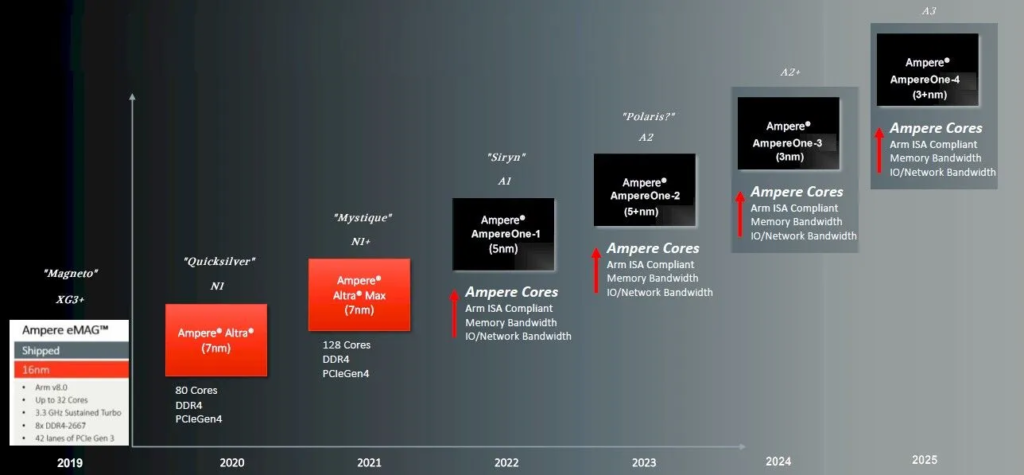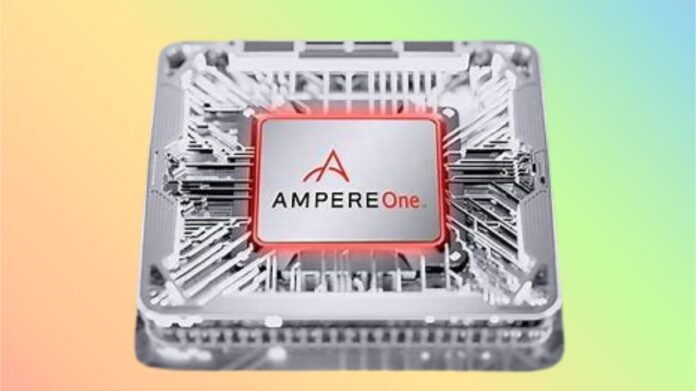AmpereOne
With its emphasis on cloud-native solutions, Ampere Computing has been creating quite a stir in the data centre processor market. Their Ampere Altra processors were remarkable in terms of performance and core density, and the next AmpereOne-3 CPU is expected to set new standards.
AmpereOne CPU
AmpereOne-3 CPU
Considerable progress has been made with the AmpereOne-3. Here’s a detailed look into what now understand:
A Core Bonanza Has 256 Cores
A significant improvement over the 192 cores of the current AmpereOne generation, the AmpereOne-3 CPU has an astounding 256 cores. This results to enormous parallel processing capacity, which is perfect for managing heavy workloads in cloud settings.
TSMC 3nm: Faster, More Efficient, Smaller
In order to construct the AmpereOne-3 CPU, Ampere is utilizing TSMC’s state-of-the-art 3nm manufacturing technique. The process of miniaturization makes it possible to fit more transistors onto a given chip area, which could result in improved power efficiency and notable performance gains.
Modular-Adaptive Chiplet Design
It is said that a chiplet design is used in the AmpereOne-3 CPU. Using this method, the processor is divided into smaller, modular parts. There are various benefits to connecting these chiplets, including:
Utilising Next-Gen Connectivity for I/O
The AmpereOne-3 CPU is anticipated to use PCIe 6.0, the latest generation of PCI Express technology. This results in much quicker communication between the CPU and other parts of the system, such as storage and GPUs, allowing for more efficient data flow and better system performance overall.
Integrating DDR5 Memory for Speed
The AmpereOne-3 CPU is probably going to include DDR5 memory in addition to its many cores and sophisticated I/O. Comparing DDR5 to its predecessor, DDR4, reveals significant increases in memory bandwidth. In order to feed the hungry cores and prevent bottlenecks, this guarantees the processor has enough memory access speed.

Potential Uses for AmpereOne-3
Because of its architecture, the AmpereOne-3 CPU is ideal for a range of cloud-based applications.
High-Performance Computing (HPC)
The AmpereOne-3 CPU large core count and effective design make it perfect for demanding computing jobs like weather forecasting and intricate scientific simulations.
Cloud AI
The AmpereOne-3 CPU is ideally suited for training and implementing AI models on the cloud due to its capacity to manage huge datasets and efficiently execute parallel processing.
Cloud Gaming
With the demand for cloud gaming increasing, strong processors that can produce lag-free, fluid experiences are needed. A large density of virtual machines for cloud gaming services may be supported by the AmpereOne-3’s capabilities.
Cloud-Native Applications
The cloud-centric architecture of the AmpereOne-3 CPU makes it perfect for running a wide range of cloud-based applications, including databases, web servers, data analytics, and machine learning.
AmpereOne-3 Ecosystem
The AmpereOne-3’s ability to succeed will probably depend on a strong ecosystem of complementary technologies and software improvements. This is what to search for:
Software Interoperability
Major cloud service providers and software vendors must modify their products to properly take use of the AmpereOne-3’s distinct design and number of cores.
Tools and Libraries for Development
To fully utilize the AmpereOne-3 CPU, developers will need a complete suite of tools and libraries created especially for it.
Optimising servers and motherboards
To fully utilize the AmpereOne-3’s potential, hardware solutions such as effective cooling and power supply systems must be developed by server and motherboard manufacturers.
How the AmpereOne-3 Could Change Things
The AmpereOne-3 CPU has the potential to revolutionize the cloud data centre processor market because to its remarkable core count, state-of-the-art manufacturing process, and sophisticated functionality. Its emphasis on efficiency and cloud-native solutions puts it in a good position to handle the ever expanding needs of cloud computing.
Cutting-Edge Manufacturing
To construct the AmpereOne-3 CPU, Ampere is utilizing TSMC’s most recent 3nm manufacturing unit. Greater performance and efficiency may result from this miniaturization since more transistors may be crammed into a given area.
Chiplet Illustration
Rumor has it that the AmpereOne-3 employs a chiplet architecture. This indicates that the CPU is probably constructed from smaller, modular parts that are able to be linked together. This method has benefits in terms of scalability and production flexibility.
Future-Generation Networking
The AmpereOne-3 CPU is anticipated to facilitate speedier communication between the CPU and other components by supporting PCIe 6.0, the next iteration of PCI Express. Furthermore, DDR5 memory is probably going to be used for faster data transfer speeds.
AmpereOne-3 Release Date
Sometime in 2025, the AmpereOne-3 CPU is anticipated to be released.
Overall, it appears that the AmpereOne-3 is a very strong and effective data centre CPU. It has many cores, state-of-the-art manufacturing technology, and next-generation networking. It seems to be a big contender in the cloud computing sector when it launches in 2025.
AmpereOne-3 Processor Specs(Rumors)
| Feature | Specification |
|---|---|
| Cores | 256 |
| Manufacturing Process | TSMC 3nm |
| Architecture | Chiplet Design |
| Instruction Set Architecture (ISA) | Likely Armv9 or newer |
| Cache | (Details not yet available) |
| L1 Cache | (Details not yet available) |
| L2 Cache | (Details not yet available) |
| L3 Cache | (Details not yet available) |
| TDP (Thermal Design Power) | (Details not yet available) |
| Memory Support | DDR5 |
| Interconnect | PCI Express 6.0 |
| Release Date | 2025 (Estimated) |


